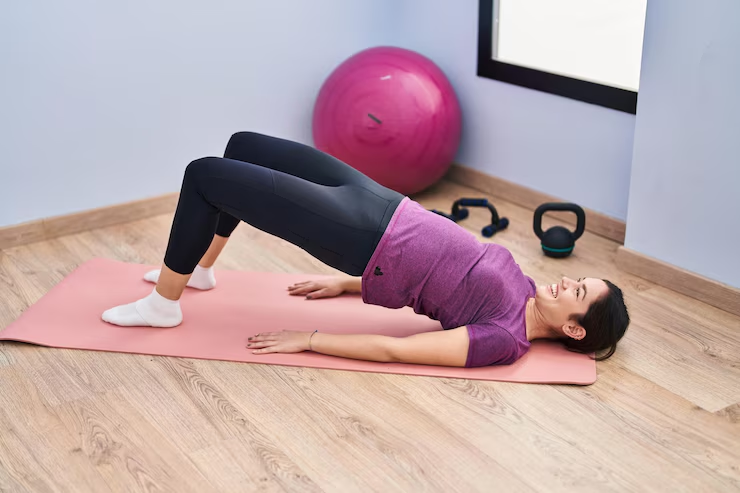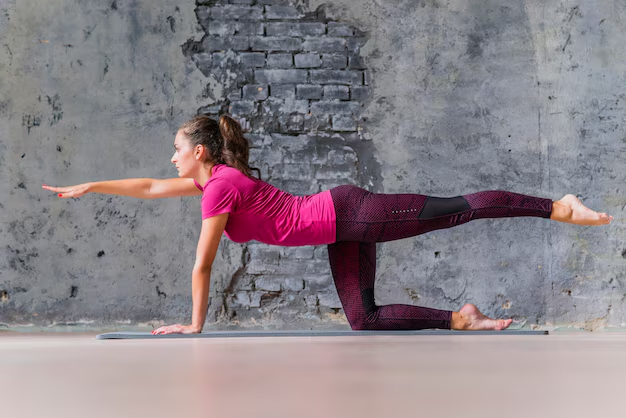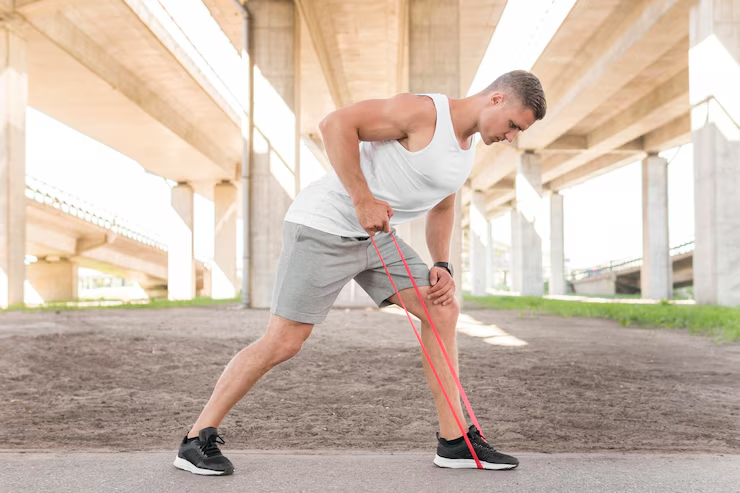The sacroiliac (SI) joint is a small but vital joint located where the spine connects to the pelvis. It plays a key role in stabilizing the lower body by transferring the weight of the upper body to the legs during activities like walking, standing, or lifting. When the SI joint functions properly, it allows for smooth, pain-free movement.
However, issues such as inflammation, trauma, pregnancy-related ligament changes, or joint degeneration can lead to dysfunction. This can cause pain in the lower back, buttocks, or hips, and can make daily activities challenging. SI joint pain is often mistaken for general lower back pain, which makes proper diagnosis and care essential.
One of the most effective ways to manage and prevent SI joint problems is through targeted exercises to strengthen the SI joint. These exercises improve pelvic stability, strengthen surrounding muscles, and restore balance, ultimately reducing pain and enhancing overall mobility and function.

One of the most effective ways to manage or prevent SI joint dysfunction is through targeted SI joint exercises that promote stability, flexibility, and strength. In this comprehensive guide, we will explore the top 8 exercises to strengthen the SI joint, prevent pain, and promote long-term health.
What Is the SI Joint ?
The sacroiliac (SI) joint is a crucial connector between your spine and pelvis. Specifically, it links the sacrum—the triangular bone at the base of the spine—with the iliac bones on each side of the pelvis. This joint helps stabilize your lower body and plays an important role in posture and movement.
Although the SI joint allows only minimal movement, it is essential for absorbing shock and distributing weight between the upper body and lower limbs. This subtle motion is what helps protect the spine and hips during everyday activities like walking, climbing stairs, or bending.
When dysfunction occurs—due to injury, inflammation, or instability—pain can radiate through the lower back, hips, or legs. That’s why it’s important to incorporate specific exercises to strengthen the SI joint. These exercises help stabilize the pelvis, reinforce the surrounding muscles, and reduce strain on the joint, allowing for better movement and less pain over time.
Common Causes of SI Joint Dysfunction
✅ Trauma or Injury to the Pelvis or Lower Back: Accidents, falls, or sudden impacts can misalign or strain the sacroiliac joint, leading to pain and instability. Incorporating exercises to strengthen the SI joint can help restore balance and improve joint resilience after trauma.
✅ Pregnancy and Childbirth: Hormonal changes during pregnancy loosen ligaments and alter pelvic alignment to prepare for childbirth. This can lead to SI joint instability. Gentle exercises to strengthen the SI joint help stabilize the pelvis and reduce discomfort during and after pregnancy.
✅ Arthritis or Degenerative Joint Diseases: Conditions like osteoarthritis can wear down the cartilage in the SI joint, causing pain and stiffness. Targeted exercises to strengthen the SI joint can support the area, reducing load on the joint and easing symptoms.
✅ Leg Length Discrepancies: Uneven leg lengths create imbalanced movement and added stress on one side of the SI joint. Regular exercises to strengthen the SI joint can promote muscle balance and prevent asymmetrical strain.
✅ Repetitive Stress from Sports or Work: Activities that involve heavy lifting or twisting can overwork the SI joint. Performing exercises to strengthen the SI joint helps the body handle repetitive motion more safely and efficiently.
✅ Poor Posture and Weak Core/Gluteal Muscles: Weakness in the core and glutes contributes to poor pelvic alignment, increasing SI joint stress. Strength-focused exercises to strengthen the SI joint improve posture, enhance stability, and reduce the risk of chronic pain.
Symptoms of SI Joint Issues
Pain in the lower back, buttocks, or hips
Pain radiating into the groin or upper legs
Stiffness or instability when standing or walking
Discomfort while sitting or lying on one side
Why Exercise Matters for SI Joint Health
The SI joint is not surrounded by strong ligaments alone; it also relies on muscular support. By strengthening the muscles that stabilize the pelvis, you:
Reduce joint stress
Improve alignment
Enhance mobility
Prevent future injuries
Top Exercises to Strengthen the SI Joint
Glute Bridges
Glute Bridges are one of the most effective exercises to strengthen the SI joint, especially because they target the gluteal muscles and core, which play a crucial role in stabilizing the pelvis. A strong, balanced pelvis helps reduce strain on the SI joint and supports proper alignment of the lower spine.

To perform a Glute Bridge, lie on your back with your knees bent and feet flat on the floor, hip-width apart. Engage your core, press through your heels, and lift your hips off the ground until your body forms a straight line from shoulders to knees. Squeeze your glutes at the top, hold for a few seconds, then lower slowly. Repeat for 10–15 reps.
Incorporating Glute Bridges into your routine of exercises to strengthen the SI joint can improve pelvic control, reduce instability, and relieve lower back pain. They are beginner-friendly and can be progressed with resistance bands or weights as strength improves.
Purpose: Strengthens the gluteus maximus and supports the lower back and pelvis.
How to Do It:
Lie on your back with knees bent and feet flat on the floor, hip-width apart.
Tighten your abdominal muscles.
Press your heels into the floor and lift your hips until your knees, hips, and shoulders form a straight line.
Hold for 3–5 seconds at the top.
Slowly lower your hips back to the ground.
Reps: 2–3 sets of 10–15 reps
Why It Works: Activates the posterior chain, especially the glutes, to stabilize the SI joint.
Clamshells
Clamshells are one of the most beneficial exercises to strengthen the SI joint, particularly because they activate the gluteus medius—a key muscle responsible for pelvic stability. Weakness in this area often contributes to SI joint dysfunction, leading to lower back or hip pain.
To perform Clamshells, lie on your side with your legs stacked and knees bent at a 90-degree angle. Keep your feet together and slowly lift your top knee as high as you can without rotating your hips or lower back. Pause briefly at the top, then lower your knee back down with control. Aim for 12–15 repetitions on each side.
Incorporating Clamshells into your routine of exercises to strengthen the SI joint can greatly improve hip alignment and reduce stress on the sacroiliac joint. These exercises are low-impact, simple to perform, and highly effective for building pelvic strength and balance—essential for both pain relief and injury prevention.
Purpose: Strengthens the hip abductors and external rotators, especially the gluteus medius.
How to Do It:
Lie on your side with your legs stacked and knees bent at a 90-degree angle.
Keep your feet together and slowly lift the top knee while keeping your hips stable.
Avoid rotating your pelvis backward.
Lower the knee back to the starting position.
Reps: 2–3 sets of 12–15 reps on each side
Why It Works: Strengthens small but crucial stabilizer muscles around the pelvis and hip.
Bird Dog

The Bird Dog is a core-stabilizing movement often recommended in exercises to strengthen the SI joint. It targets the deep abdominal muscles, glutes, and lower back—key areas that support the sacroiliac joint. By improving coordination and balance, the Bird Dog enhances pelvic stability and reduces strain on the SI joint during daily movements.
To perform the Bird Dog, begin on your hands and knees in a tabletop position. Slowly extend your right arm forward and your left leg straight back, keeping your hips level and your core engaged. Hold for a few seconds, then return to the starting position and switch sides. Perform 8–12 repetitions per side with control and focus.
Adding the Bird Dog to your routine of exercises to strengthen the SI joint improves muscle activation, posture, and spinal alignment. It’s a low-impact, safe option that’s especially effective for reducing SI joint discomfort and preventing future instability.
Purpose: Strengthens the core, glutes, and back while improving balance and coordination.
How to Do It:
Start on your hands and knees in a tabletop position.
Extend your right arm and left leg simultaneously until they are parallel to the floor.
Hold for 3–5 seconds, engaging your core.
Slowly return to the starting position and switch sides.
Reps: 2–3 sets of 10–12 reps per side
Why It Works: Promotes core control and pelvic stability, essential for SI joint health.
Dead Bug
The Dead Bug is a core-strengthening movement that is highly effective among exercises to strengthen the SI joint. It targets the deep abdominal muscles while encouraging stability in the pelvis and lower back. A strong core is essential for maintaining proper alignment and reducing stress on the sacroiliac joint during movement.
To perform the Dead Bug, lie on your back with your arms extended toward the ceiling and your knees bent at 90 degrees above your hips. Slowly lower your right arm and left leg toward the floor while keeping your lower back pressed against the ground. Return to the starting position and repeat on the other side. Perform 8–12 reps per side with control.
Incorporating the Dead Bug into your routine of exercises to strengthen the SI joint helps enhance neuromuscular coordination, core control, and pelvic stability. It’s a safe and efficient exercise that supports long-term SI joint health and reduces pain with consistent practice.
Purpose: Core strengthening with minimal spinal pressure.
How to Do It:
Lie on your back with arms extended toward the ceiling and knees bent at 90 degrees.
Engage your core and slowly lower your right arm and left leg toward the floor.
Keep your lower back flat on the ground.
Return to starting position and switch sides.
Reps: 2–3 sets of 10 reps per side
Why It Works: Targets deep core muscles like the transverse abdominis, which stabilize the spine and pelvis.
Side-Lying Leg Raises
Side-Lying Leg Raises are a simple yet highly effective addition to exercises to strengthen the SI joint. This movement targets the gluteus medius and minimus—key muscles that stabilize the pelvis and reduce strain on the sacroiliac joint. Strengthening these muscles helps correct imbalances that often contribute to SI joint pain.

To perform the exercise, lie on your side with your legs extended straight and stacked on top of each other. Rest your head on your lower arm and place your top hand on the floor for balance. Keeping your top leg straight, slowly raise it upward to about 45 degrees, then lower it back down with control. Repeat 10–15 reps on each side.
Incorporating Side-Lying Leg Raises into your routine of exercises to strengthen the SI joint improves hip and pelvic stability, enhances alignment, and supports pain-free movement. It’s an accessible, low-impact option that delivers long-term benefits for SI joint health.
Purpose: Strengthens hip abductors and stabilizes the pelvis.
How to Do It:
Lie on your side with legs straight and stacked.
Keep your lower leg relaxed and slowly raise your top leg.
Avoid tilting your pelvis backward.
Hold briefly at the top, then lower.
Reps: 2–3 sets of 10–15 reps per side
Why It Works: Strong abductors prevent hip drop and promote pelvic alignment.
Pelvic Tilts
Pelvic Tilts are a foundational movement often used in exercises to strengthen the SI joint. This gentle yet powerful exercise engages the lower abdominal and pelvic muscles, helping to stabilize the sacroiliac joint and reduce discomfort caused by imbalance or misalignment.
To perform Pelvic Tilts, lie on your back with your knees bent and feet flat on the floor, hip-width apart. Take a deep breath in, then as you exhale, gently flatten your lower back against the floor by tilting your pelvis upward. Hold this position for a few seconds, then return to the starting position. Repeat the movement for 10–15 controlled repetitions.
Including Pelvic Tilts in your daily exercises to strengthen the SI joint routine helps build core awareness, improve posture, and support the spine and pelvis. This low-impact movement is especially effective for beginners and individuals experiencing SI joint discomfort, offering safe relief and long-term strengthening benefits.
Purpose: Strengthens the lower abdominals and improves pelvic positioning.
How to Do It:
Lie on your back with knees bent and feet flat.
Tighten your abdominal muscles and flatten your lower back against the floor.
Hold for 5 seconds.
Relax and repeat.
Reps: 2–3 sets of 10–12 reps
Why It Works: Improves core engagement and neutral pelvic positioning—both critical for SI joint function.
Modified Side Plank

The Modified Side Plank is a powerful yet approachable core stability movement often included in exercises to strengthen the SI joint. It targets the obliques, transverse abdominis, and gluteal muscles, all of which are essential for maintaining pelvic alignment and reducing stress on the sacroiliac joint.
To perform the Modified Side Plank, begin by lying on your side with your knees bent and stacked. Prop yourself up on your forearm, ensuring your elbow is directly beneath your shoulder. Engage your core and lift your hips off the ground, forming a straight line from your shoulders to your knees. Hold the position for 15–30 seconds, then lower slowly and switch sides.
Incorporating the Modified Side Plank into your routine of exercises to strengthen the SI joint can significantly improve lateral stability, posture, and core strength. It’s especially beneficial for individuals with SI joint dysfunction who need safe, controlled ways to support and protect the lower back and pelvis.
Purpose: Strengthens the obliques and hip stabilizers with less strain.
How to Do It:
Lie on your side with knees bent.
Prop yourself up on your forearm.
Lift your hips off the ground to form a straight line from head to knees.
Hold for 15–30 seconds.
Reps: 2–3 holds per side
Why It Works: Builds lateral core strength, which stabilizes the pelvis and reduces shear forces on the SI joint.
Standing Hip Hikes
Standing Hip Hikes are an excellent addition to exercises to strengthen the SI joint, as they focus on engaging the gluteus medius and other stabilizing muscles of the pelvis. This movement improves pelvic control and alignment, which is crucial for reducing stress on the sacroiliac joint and preventing further dysfunction.
To perform Standing Hip Hikes, stand on a low step or sturdy platform with one foot flat on the surface and the other leg hanging off the edge. Keep both legs straight and slowly lower the free leg by dropping your hip downward, then use your standing leg’s hip muscles to lift the opposite side back to level. Perform 10–15 reps on each side.
Incorporating Hip Hikes into your routine of exercises to strengthen the SI joint helps enhance single-leg stability, correct muscle imbalances, and reduce compensatory movements that contribute to pain. It’s a simple but powerful move that supports long-term SI joint health and mobility.
Purpose: Targets the quadratus lumborum and glute medius for pelvic control.

How to Do It:
Stand on a step or low platform with one foot hanging off the edge.
Lower the hanging leg by dropping your hip, then lift it back up using the muscles of the standing side.
Keep your spine straight and avoid leaning.
Reps: 2 sets of 10–12 reps per side
Why It Works: Enhances unilateral pelvic control, which is vital for walking and balance.
Bonus Tips for Effective SI Joint Training
✅ Warm Up Properly: Before beginning any exercises to strengthen the SI joint, always warm up with 5–10 minutes of gentle cardio like walking or cycling. Follow that with dynamic stretches such as leg swings or hip circles to increase blood flow and prepare your joints for movement.
✅ Engage the Core: During all exercises to strengthen the SI joint, activate your deep core muscles—especially the transverse abdominis. These muscles wrap around your midsection like a corset and help stabilize the pelvis and spine, reducing unnecessary pressure on the SI joint.
✅ Breathe Correctly: Proper breathing supports core engagement. Inhale as you prepare for a movement, and exhale during the effort phase. Holding your breath can increase intra-abdominal pressure and strain the sacroiliac joint.
✅ Avoid Pain: While mild muscle fatigue is normal, none of the exercises to strengthen the SI joint should cause sharp, shooting, or intense pain. If you experience discomfort, stop immediately and reassess your form or seek guidance from a professional.
✅ Use Support if Needed: If you’re new to these exercises or recovering from SI joint issues, use props like a yoga mat, cushion, or resistance band to improve comfort and maintain proper alignment during your exercises to strengthen the SI joint.
✅ Stay Consistent: Consistency is key for success. Aim to perform exercises to strengthen the SI joint at least 3–4 times per week. Over time, regular practice builds muscle memory, improves pelvic stability, and supports long-term joint health.
Conclusion
The sacroiliac (SI) joint is a small yet essential component of your body’s kinetic chain, playing a critical role in stabilizing your pelvis and transferring weight between your upper and lower body. Despite its importance, it’s often overlooked—until pain or dysfunction occurs. Whether you’re recovering from an injury, managing chronic discomfort, or aiming to improve your overall physical performance, incorporating exercises to strengthen the SI joint is crucial for long-term health and mobility.

Focusing on the muscles that support the SI joint—such as the core, glutes, and lower back—helps reduce stress on the joint and restore proper alignment. These exercises to strengthen the SI joint are designed to enhance stability, correct imbalances, and relieve pain caused by strain or instability.
The top 8 SI joint exercises outlined in this guide offer a safe, effective way to protect your spine, increase function, and regain comfort. With consistent practice and supportive lifestyle changes, lasting relief is absolutely possible.
FAQs
Q1. What are the best exercises to strengthen the SI joint?
The most effective exercises to strengthen the SI joint focus on engaging the core, glutes, and lower back muscles. Top examples include glute bridges, bird dogs, clamshells, dead bugs, and side-lying leg raises. These movements help stabilize the pelvis, align the joint, and reduce strain on the sacroiliac area.
Q2. How often should I do exercises to strengthen the SI joint?
For optimal results, perform exercises to strengthen the SI joint at least 3 to 4 times per week. Consistency is vital. Begin with low-impact movements and gradually progress as your strength and joint stability improve. Avoid overtraining to prevent irritation.
Q3. Can exercises to strengthen the SI joint relieve pain?
Yes, properly targeted exercises to strengthen the SI joint can significantly reduce pain. Strengthening the supporting muscles improves joint alignment, decreases inflammation, and enhances mobility, which collectively ease discomfort in the lower back and hips.
Q4. Is it safe to do these exercises if I have SI joint dysfunction?
Most exercises to strengthen the SI joint are safe when done with correct form and without causing sharp pain. Start with gentle movements like pelvic tilts and bird dogs. Avoid high-impact or twisting exercises and consult a healthcare professional if needed.
Q5. Should I combine SI joint exercises with other treatments?
Absolutely. While exercises to strengthen the SI joint are essential, combining them with posture correction, ergonomic support, manual therapy, and anti-inflammatory strategies enhances results. A well-rounded approach supports long-term relief and improved joint function.

